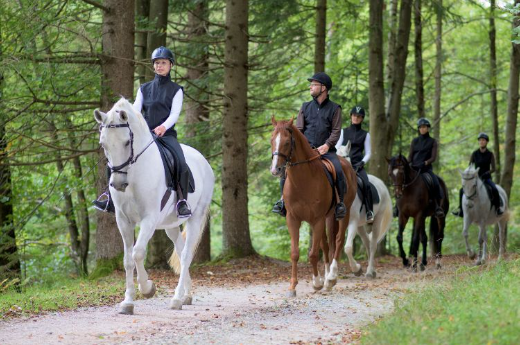Most horse riders know that all horse riding styles fall underneath two broad umbrellas: English and Western. However, a bunch of disciplines fall under each of these main categories.
In this post, we'll introduce you to the most popular disciplines of each riding style and their main characteristics.

English Vs. Western Horse Riding Styles
Before we dive into the disciplines, let's first look at the differences between the English and Western horse riding styles.
The primary difference between these two styles lies in the way the horse saddle seat is used.
The English horseback riding style is known for its smaller and lighter saddle, and it's often the choice of beginner riders. For people with little riding experience, an English saddle will bring them close to the horse, giving them greater control.
Another distinct feature of this riding style is the fitting jacket and helmet that the English rider wears. (Speaking of helmets, check out this guide on KASK vs.Samshield helmets to explore the differences between the two wearables.)
Western style, on the other hand, is known for its deeper seat that helps you make a turn easily in a race. Traditional Western riders also wear jeans, a shirt, and a hat, rather than the fitted English attire.
Given this, these two styles include multiple disciplines that we'll introduce in the next section.
English Riding Styles

Each equestrian discipline within the English style comes with a variety of rules you need to be aware of. The following are three of the most popular English riding disciplines:
-
Dressage
Dressage is definitely at the top of the most popular English disciplines.
Also known as horse ballet, dressage is an equestrian sport that showcases the rider's ability to guide their horses to perform complex movements. It's an Olympic sport where the rider trains the horse to perform a set of predetermined gaits and maneuvers.
For the horse to achieve a higher score in the competition, it should execute the required maneuvers flawlessly. The higher control and grace the rider has on their horse, the better they're at dressage.
Perfect communication between the horse and dressage rider is also vital to optimal performance. Given that, the competition's winner is the horse with the most accurate and elegant movements.
-
ٍShow Jumping
Many people are familiar with the show jumping discipline, even if they’re not horse riders. You probably remember watching it at the Olympic Games.
Show jumping is an equestrian style of riding that assesses the horse's ability to quickly navigate a series of obstacles varying in complexity and height. It's a fast-paced discipline that demonstrates high agility and quick responsiveness.
The rider aims to end the competition with the fewest penalties possible. To achieve this, they guide their horses to jump over the obstacles precisely.
Whenever the horse knocks down a barrier or fails to execute a jump, judges give it a certain number of negative points, called penalties. The same applies if they exceed the time limit allowed.
At the show's end, the rider with the fewest penalties and fastest time wins the competition.
-
Eventing
Eventing is an equine sport that combines different riding disciplines. It includes elements of stadium jumping, dressage, and cross-country jumping.
To be good at it, the rider and the horse should possess diverse skill sets. These skills range from endurance to adaptability and versatility.
In eventing competitions, equestrians go through a dressage test, perform a cross-country course, and end with a stadium jumping test.
During the competition, judges give penalties to horse riders for any mistake or failed movement. Ultimately, the winner is the participant with the lowest penalty score.
Recently, eventing rules have been updated to state that if the horse or rider falls anytime during the competition, they're eliminated instantly.
Western Riding Styles

Western horseback riding styles demand high athleticism and robust bonding between the horse and the rider.
The following are three of the most popular Western riding disciplines:
-
Cutting
Cutting is a discipline centered around the horse's ability to drive a cow away from its herd and direct it toward a specific place.
In this competition, riders work on guiding the horse to separate the cow from its herd. Then, they prevent it from returning to its herd for a particular period.
So, an excellent horse should be able to anticipate the cow's movements and respond to them quickly.
In a cutting contest, judges assess how well the horse prevents the cow from reaching the herd. They also evaluate the rider's skills in controlling the horse.
Quarter horses with firm and strong bodies are the best breeds for this competition. Besides their strength, these horses inherently possess the required wisdom and intelligence to perform this activity perfectly.
-
Endurance Riding
As the name suggests, endurance riding is a challenging stamina test for the horse and its rider. It's a long-distance race typically ranging from 25 up to 500 miles.
This equestrian sport was initially invented to evaluate cavalry mounts's ability to participate in wars.
It became a sport in the middle of the previous century and quickly gained popularity worldwide.
Arabian breeds are the best horses for this competition because of their unparalleled stamina under a wide variety of conditions.
-
Barrel Racing
Here we are with a highly thrilling discipline, barrel racing. It's a Western riding style that evaluates the horse's speed and agility.
This evaluation is done as the rider guides the horse to navigate around barrels as quickly as possible in a circular pattern.
The horse rider should train the horse to perform the maneuvers precisely without hitting the barrels. They should also aim to score the fastest time.
The winner is the horse rider who finishes the required navigation faster without knocking over barrels.
A quick reminder before wrapping up: Do you have difficulty riding your horse during winter due to freezing weather? Check out this short tips guide to help you stay warm during that time.
Wrapping Up
By now, you know that horse riding styles fall into two primary categories: Western and English. Each of those styles includes a wide variety of disciplines.
Dressage, eventing, and show jumping are three of the most popular English disciplines.
Western style, on the other hand, is well-known for its endurance, cutting, and barrel racing disciplines.
Hopefully, this article has helped you gain solid knowledge about different styles of horse riding and their disciplines.


